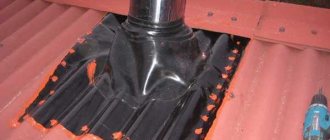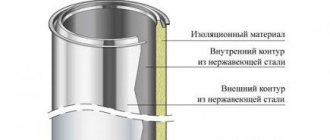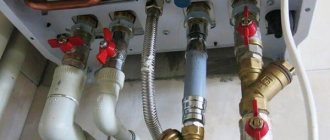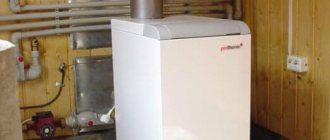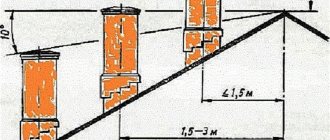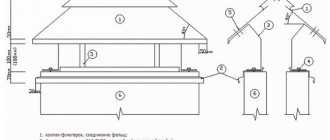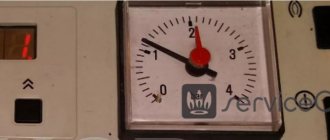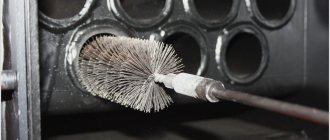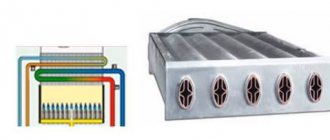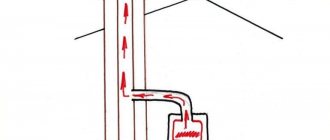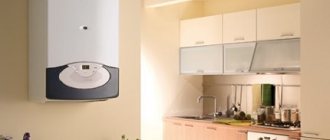Installation of boiler equipment and its efficient operation is impossible without a chimney.
The correct choice of materials and compliance with standards when connecting is the key to your safety.
Gas services strictly control the commissioning process and may fine violators or forcibly disconnect the user from the gas supply.
Material requirements
Basic requirements for materials:
- fire resistance;
- anti-corrosion properties;
- resistance to the effects of acid formed as a result of the interaction of condensate with combustion products;
- long period of use.
Brick chimney. It has low draft and is prone to rapid destruction due to the formation of abundant condensation on the surface, which turns into an ice crust during the cold season. Ideal only for fireplaces or as a kind of cover for a stainless steel chimney.
Made from stainless steel . It has a lot of advantages, which makes it one of the first in popularity among its peers. It has good traction, fire resistance and anti-corrosion, and a long service life (especially dual-circuit models). The modular assembly method allows you to create steel chimneys of different configurations and is accessible even to a non-professional. Compatible with high-power boilers. Will serve you for 15 years.
Chimneys made of galvanized steel behave much worse during use. Galvanization is susceptible to rust. Service life – maximum 5 years.
Ceramic chimney. Externally, it is as massive as brick. The installation option is strictly vertical only. Austrian manufacturers have developed models of ceramic chimneys with an external contour not only made of ceramics, but also of metal. They are much lighter, but when installing them you need to calculate the loads on the foundation and walls. Warranty up to 30 years.
Asbestos cement pipes . Short service life (5 years), difficult to install, not environmentally friendly. Even the low price of the material cannot serve as a compelling reason to choose such a chimney. Overheating can simply rupture the pipe. Suitable for occasional use in the countryside.
Coaxial - made of aluminum in the form of two sandwich pipes with different diameters, located one inside the other. The external one is intended for supplying air, and the internal one is for removing combustion products. The structure is prefabricated. The location is most often horizontal.
Advantages of a coaxial chimney:
- Safety
- Increased efficiency of the heating system
- Environmental friendliness
A useful article on the topic - do-it-yourself ventilation in a private house, diagram and drafting. Do-it-yourself air conditioner installation and rules for its use, details here.
Types of chimneys based on materials of manufacture
Chimney pipes for a gas boiler are made of the following materials:
- brick;
- ceramics;
- steel;
- combination of materials.
Brick chimney
The ideal cross-section of a pipe through which smoke passes at the highest speed is a circle, and it is irrational to lay out a chimney with a round cross-section made of brick. In addition, the brick needs to be fire-resistant, but this does not save the channel walls from fouling with soot and destruction due to the influence of condensing acidic components of gas combustion products. Therefore, chimneys for solid fuel heating boilers or stoves made of identical material are laid out of brick.
The process is labor-intensive, as well as the need for careful selection of heat-resistant bricks and a binder with heat-resistant characteristics.
Construction begins with the construction of a strong individual foundation inside the building’s contour without a rigid connection with load-bearing walls and floor slabs. It is not advisable to carry out this work yourself, without having the skills to work in laying furnaces, but knowledge of the technology will help control the work of a professional performer.
One of the conditions for ensuring sufficient traction is the required amount of elevation of the pipe head above the roof ridge, depending on the location. The diagram demonstrates this better than the description.
But the presence of draft, nevertheless, does not completely eliminate the factor of the destructive effect of smoke, its acid-forming components and condensate on the brick.
The influence of these factors can be eliminated by installing a chimney from a steel pipe and covering it with refractory bricks. The ideal channel material is stainless steel, resistant to chemically aggressive substances and moisture.
Based on the nuances of using brick when constructing a chimney, its use for equipping a heating system based on a gas boiler is not justified.
Chimney made of ceramic pipes
The ceramic smoke exhaust pipe is a prefabricated structure. The outer body is a load-bearing frame made of lightweight concrete. There is a ceramic pipe inside it. The space between the inner and outer layers is filled with a special heat-insulating material.
A ceramic chimney is assembled from individual elements 20-60 cm long, having a connecting shaped socket at one end, which during assembly is treated to seal the joints with an acid-resistant adhesive.
The ceramic channel is insulated from the outside with heat-resistant thermal insulation and lined with hollow expanded clay concrete blocks or heat-resistant bricks with cement mortar. Grooves in the blocks promote ventilation of the insulation and neutralize thermal expansion of the ceramics. The design and profile of the blocks can be different - depending on the diameter of the chimney and the number of ceramic pipes in the channel.
To facilitate installation, manufacturers offer ready-made kits of ceramic chimneys, which include all the necessary fittings and have a guaranteed service life of 30 years or more.
Installation of a ceramic chimney
Ceramic chimneys are rarely installed outside, since the external design will require an additional reinforcing shell made of bricks or blocks.
The device begins with determining the exit location of the channel in the roof. Then they project this place down with a construction plumb line, remove the soft soil, plan the site, mark the contour of the foundation and make a crushed stone backfill.
Foundation
If the base for the chimney is the foundation of the house (the structure is a cushion) or a concrete floor with reinforcement, then the installation of the duct is carried out on it, having previously waterproofed the site.
The dimensions of the foundation in plan and its depth depend on the properties of the soil and the parameters of the chimney - sectional contour and weight (number of floors of the building).
Important! The foundation for the chimney is constructed independently; it should not have connections with the base of the building.
Formwork is installed along the contour marked on the ground, after which reinforcement is made - a mesh of variable profile reinforcement with a diameter of 10-12 mm is laid, connected with a knitting wire to a cell of 10x10 or 12x12 cm.
The foundation is poured with concrete of a grade not lower than M-200. A week after installation, it will gain 70% strength, and you can begin laying the chimney by waterproofing the area under it (roofing felt, bitulin).
Installation of blocks
Ceramic elements are laid in accordance with the design of the installation joints; a heat-resistant compound is applied to the joints of the elements before installation, which not only firmly fixes the joint after curing, but also seals it. It is convenient to lay the composition with a mounting syringe, or, if not available, with a trowel. The excess mixture that comes out after installation is immediately rubbed down with a piece of foam rubber flush with the joint - there should be no drips or bulges.
Important! It is prohibited to “revive” a prepared but already hardening composition by adding water and stirring - a significant part of the strength of such glue will be lost.
The laying of the supporting frame is carried out depending on the design of concrete or brick blocks, which are made either solid with an installation hole in the cross-section, or detachable, laid around the pipe.
In the lower tier, the first module should be located with a device for collecting and draining condensate. To do this, use a grinder to make a slot in a concrete or brick block to bring the outlet pipe out. A solution is applied to the base, the mounting area of the product is wetted, and the block is placed in place, after which a ceramic module with an outlet pipe is installed in it, also on the cement mortar.
The verticality of the mounted sections is controlled by the building level. When laying the walls, it is also necessary to provide for the location of inspection hatches and connections for the outlet pipe of the gas boiler in order to mount these elements in areas corresponding in height with the desired orientation.
Thermal insulation is laid around the pipe by inserting it from above into a block installed on the solution with preliminary adjustment of the dimensions.
Important! Horizontal joints of ceramic modules and hollow concrete blocks of the supporting frame when passing through the floor slab should not be located in its plane - a solid element should pass through the slab, equipped along the perimeter of contact with it with a heat-resistant elastic sealant that neutralizes possible deformations.
To enhance the strength of the outer load-bearing frame, the blocks are provided with through holes - reinforcement channels, which must be aligned during masonry production. Before the solution hardens, pieces of steel reinforcement of variable profile are inserted into these holes so that the joints of the rods with each other fall in the middle of the block, and not at the seam. The diameter of the reinforcement is selected so that after installing the rod there is space left in the reinforcement channel to fill it with liquid cement mortar. The reinforcement is straightened and cut into pieces that allow 2-3 blocks to be fastened together.
The external seams between the blocks or bricks of the supporting frame are also carefully rubbed, and excess mortar is removed before curing, so that subsequently there is no need to knock on the channel to remove it.
The cross-section of a ceramic chimney for gas boilers with a closed combustion chamber is somewhat different - in the supporting frame blocks there is a separate channel for air supply to the burners, which, like the reinforcement holes, must be carefully aligned during installation, but the technology for laying structures is identical to that described above.
The top of the pipe must be equipped with a protective cap to prevent moisture and foreign objects from entering the chimney. The aerodynamics of the exit of gases depends on the shape of the head, so it is better to install an industrially produced product rather than experiment with homemade crowns.
The finishing of the outer surface of the chimney in the premises is carried out depending on the interior of the home; the most practical is cladding with ceramic tiles with appropriate temperature characteristics.
Advantages of a ceramic chimney:
- the inner surface of ceramic pipes is covered with a layer of heat-resistant glaze, which, unlike brick, does not contribute to the deposition of soot - one of the conditions for good traction;
- the glaze is waterproof, which prevents the pipe from absorbing condensate and destroying the walls when it freezes - condensing compounds flow down into a special sump, which ensures the strength of the chimney body;
- low intensity of soot layering - practically no soot settles on a smooth surface, and most of it flies into the atmosphere along with smoke;
- ease of maintenance - soot is removed from smooth glazed walls much easier than from brick walls;
- fire safety - even if there is a certain amount of soot in the pipe, its ignition will take place without consequences, since ceramics are heat-resistant and have low thermal conductivity;
- resistance to chemicals - ceramics do not interact with acids formed during condensation of moisture and gas combustion products on the walls of the pipe;
- durability;
- ease of processing - ceramic chimney elements do not require special tools.
Disadvantages of ceramic channels:
- significant weight of the structure;
- the need to build a foundation;
- high price;
- the need for precise fitting skills.
Ceramic chimney in a steel casing
This design is a more advanced version of the previous device produced in Germany. The inner part is made of ceramics, and the outer shell is made of steel elements 60-100 cm long, assembled into a solid structure using special crimp-type fasteners. Installation is simple and can be located anywhere, including installation inside a wall - rectangular systems are produced for this purpose.
Despite the many advantages of a ceramic chimney in a steel shell, this material has a significant drawback - its high price, which prevents the growth of its popularity when used in everyday life.
Steel chimneys
For the manufacture of such channels, ordinary or stainless steel with a thickness of 0.5-0.8 mm is used. The advantages of stainless steel in this case are obvious - durability due to resistance to acids formed when nitrogen and sulfur components of smoke come into contact with condensate.
The degree of aesthetics of the design depends on the status of the building - cottages are equipped with channels made of stainless steel or with a colored enamel surface, fixed to the walls using decorative structures, country houses can be equipped with pipes made of ordinary steel painted with aluminum powder.
Pipe chimney systems are mainly located outside the home, attached to the walls using brackets of various designs, but internal placement is also possible provided the following conditions are met:
- pipe material – stainless steel;
- device of protective thermal insulation of the internal sections of the chimney to prevent burns from direct contact;
- construction of fireproof cutting around pipes at points of contact with walls and floor slabs;
- fulfillment of the requirements for the structural arrangement of chimney elements:
Installation
A foundation is not required for steel chimneys, and you can install them yourself.
Assembly is done from bottom to top. The design must include a sump for condensate with a pipe for draining it.
Prefabricated elements are connected to each other by shaped joints, the contact surfaces of which are covered with heat-resistant silicone sealant before assembly, which allows for spot repairs to dismantle the desired fragment. Crimping clamps are additionally applied over the joints.
The depth of installation of pipes on top of each other is determined by fire safety standards - no less than the radius of the mounted element.
It is allowed to have one horizontal section of pipe in the circuit, but with a length of no more than 1.0 m.
The pitch of the chimney mounting brackets on the wall is 1.5-2.0 m; each turning point (elbow) needs individual fastening to the base.
If the roof of the house is made of flammable materials, then a spark arrester deflector is installed at the end of the pipe.
To reduce the formation of condensation and increase draft, insulation is performed on the outer sections of the chimney with stone wool - a method that prevents it from getting wet. At the top of the pipe, where the insulation layer ends, a collar is installed on the channel with a downward slope around the perimeter to prevent moisture from entering the insulation from the end.
The part of the pipe facing the roof is attached to the base with three braces, evenly distributed around the circumference at 120 degrees.
Sandwich chimneys
Sandwich pipes are two steel shells of different diameters, between which a heat-resistant insulation of a certain thickness is placed. This design allows you to mount a chimney pipe for a boiler from elements that are already equipped with thermal insulation on the outside, so sandwich chimneys are equally suitable for both external and internal installation.
Based on the material used, sandwich pipes are produced in the following types:
- both shells are made of stainless steel;
- The inner pipe is made of stainless steel, the outer pipe is made of galvanized steel.
However, the resistance of steel to oxidation does not yet determine the degree of its suitability for use in smoke ducts.
The following types of stainless steel are used in the production of sandwich pipes:
- AISI 430;
- AISI 439;
- AISI 316;
- AISI 316i;
- AISI 304;
- AISI 321;
- AISI 310S.
The most inexpensive materials are steel grades AISI 430 and AISI 304, but their application is appropriate - only for external shells. The highest quality are AISI 316i, AISI 321, AISI 310S, used for both external and internal pipes, and this must be taken into account when choosing a material. The grade of steel used has a significant impact on the cost of pipes. Therefore, when looking for the best offer, you need to take into account the material of manufacture. A conscientious manufacturer always supplies its products with labels indicating the grade and thickness of the stainless steel of the internal and external contours. The dependence of the cost on the grade of steel is clearly demonstrated in the summary table of prices for stainless steel chimneys on the official website.
Installation
The construction of an external sandwich chimney begins with the installation of a starting unit on the outer wall of the building. At the starting unit, the first element of the sandwich chimney is installed - the support plate.
A tee is installed on the support plate, from which the vertical part of the chimney is installed, and an inlet hole is made in the wall according to the markings with calculations to equip the entrance with a fireproof passage and thermal insulation.
The fragments are attached to each other by inserting ends into each other, made in compliance with the required landing diameters. Crimp clamps are installed over the landing joints. But when installing pipes, two methods of their orientation are used - “along the smoke” and “along the condensate”.
When installing sandwich pipes, the following rule must be followed:
- the assembly of the horizontal section up to the tee is carried out “by smoke” - the next fragment is put on the previous one;
- the vertical section of the chimney is collected “by condensation” - the next fragment is inserted into the previous one.
Both methods of mating must be performed using sealant.
After installation, the upper part of the chimney is attached to the base with braces using a special clamp and eyes.
Self-installation of a sandwich chimney is simple only at first glance. In practice, this operation requires professional skills to perform many types of work, including at height. In addition, not only the efficiency of the gas boiler, but also the safety of the people living in the house depends on the quality of execution and compliance with technical standards. Therefore, it is recommended to undertake the independent installation of a sandwich chimney, which includes many small but important nuances, only with the participation of a professional mentor.
Chimney elements
Regardless of the material, the design includes the following elements:
- Tee with revision - a fitting for condensate is installed at the bottom of the tee
- Adapter for connecting the gas boiler pipe and the chimney
- Fastenings - brackets and clamps
- Cone shaped tip
- Bends - installed no further than 2 meters from the beginning, otherwise the boiler draft is reduced;
- Feedthrough
- Telescopic pipes
Step-by-step instructions for constructing a smoke exhaust system
Chimney location options for a gas boilerHow to install a sandwich chimney
The procedure for arranging a chimney will be considered using the example of constructing a sandwich system made of pipes. This is the most optimal and universal solution. There are 2 methods of assembling such a structure: inside the house and outside it. Explore both options and choose the one that suits you.
Outside the building
Gas chimney installation diagramChimney location for a gas boiler
First step. We connect to the heating unit nozzle a pass-through element intended for laying through the wall.
Elements for connecting a gas boiler to a chimneyConnecting a gas boiler to a chimney
Second step. We apply markings to the wall surface in accordance with the dimensions of the passage element and cut out the opening.
Hole in the wall
Third step. We remove the smoke exhaust pipe from the room.
Exiting the pipe through the opening
Fourth step. We carefully insulate the hole and the pipe passing through it.
How to make your own overlay plates
Fifth step. We attach a tee with an inspection to the pipe, then install a plug
Sandwich teePlug for inspectionConnecting a tee with inspectionConnecting a tee with inspection (bracket and clamp)
Sixth step. We extend the chimney by adding new links until the required length is reached. Having reached the planned height, we install a cone-shaped tip on the pipe. It will protect the system from precipitation and wind. To attach the pipe to the wall of the building we use brackets. The spacing of fixing elements should not be less than 200 cm.
Assembling a gas boiler chimney
Seventh step. We strengthen all joints of the structure with clamps. We tighten them with wire or bolts.
Eighth step. We paint the chimney with a special heat-resistant paint and varnish composition. It will provide adequate protection of the material from rust.
Inside the house
Inside the house
Let's start with preparation:
- we mark holes for the pipe in the ceilings and roof;
- Having checked the marks with the dimensions of the pipe, we make an opening for the chimney.
Next we deal with the actual installation of the chimney.
First step. We connect the adapter to the unit pipe.
Second step. We install the tee and revision.
Third step. We begin to build up the chimney.
Do-it-yourself chimney installation and installation
If necessary, we carry out work using the so-called. knees Where the pipe crosses the floors, we use a special protective pipe.
Docking
Fourth step. We put a stainless steel sheet on the chimney. We cut a hole in the sheet in advance, slightly larger than the diameter of the pipe. Such a sheet should be located on both sides of each floor.
Scheme for arranging a hole in the ceiling Ceiling-pass-through device Construction of a ceiling-pass-through device box Construction of the bottom of a ceiling-pass-through device box Installation of a ceiling-pass-through device Exit of the chimney pipe through a ceiling-pass-through device
Fifth step. We strengthen the joints of the structure with clamps.
Sixth step. If necessary, attach the pipe to the attic beams. To do this, we use brackets (every 400 cm) and wall clamps (every 200 cm).
Fastening the chimney with a bracket Roofing element 20/45 degrees diameter 300 mm (sandwich) Roofing passage Do-it-yourself installation and installation of the chimney Mushroom deflector
Seventh step. We install a cone-shaped tip (deflector) at the chimney outlet.
Assembly diagram for a hood for a gas boilerChimney elements
How to calculate the chimney diameter
Key parameters are cross-sectional area (outlet F cm2).
The calculation is made using the formula F = (K ∙ Q) / (4.19 ∙ √ˉ N) , where: K is a coefficient calculated empirically (0.02-0.03);
Q is an indicator of the performance of a gas appliance (indicated in the technical characteristics of the boiler);
H - chimney height.
The resulting number is adjusted by building codes and regulations.
For example, if brick is used , then the cross-section is 0.5 x 0.5 material. For asbestos cement, the diameter is at least 10 cm.
The diameter of the round chimney with a boiler power of 24 kW should be 120 mm, 30 kW - 130 mm, 45 kW - 170 mm, 55 kW - 190 mm, 80 kW - 220 mm and 100 kW - 230 mm. The minimum cross-section of rectangular channels depends on the thermal power of the boiler:
- Up to 3.5 kW - 14 by 14 cm.
- 3.5 to 5.2 kW - 14 by 20 cm.
- From 5.2 to 7.3 kW - 14 by 27 cm.
Gas chimneys
What materials are suitable for gas chimneys?
Due to the peculiarities of the chemical composition of the smoke that appears during gas combustion, the main requirement for the material is resistance to chemical aggressive environments and corrosion. Thus, there are the following types of gas chimneys:
1. Made of stainless steel. The best option. Their advantages are light weight, resistance to various corrosions, excellent traction, and operation for up to 15 years.
2. Made of galvanized steel. Not the best option compared to stainless steel. Provides poor traction and is more susceptible to corrosion. Operation for no more than 5 years.
3. Ceramics. Gaining popularity. Operation up to 30 years. However, it is necessary to take into account the high weight of the chimney when laying the foundation. Maximum thrust is only possible with vertical installation without errors.
4. Coaxial chimney. It has increased efficiency and safety, but at the same time a high price. It is a pipe within a pipe. One is for removing smoke, the other is for supplying air.
5. Brick chimney. Shows negative qualities when using gas heating. Operation is short-lived. It is permissible to use a brick chimney left over from stove heating only as an external casing for a liner made of a more suitable material.
6. Asbestos cement. Outdated option. The only positive thing is the low price.
There are a lot of options for installing a gas chimney. When choosing a material, it is worth starting from its quality characteristics. You should not skimp on your health and the safety of your loved ones.
Does the type of boiler affect the choice of chimney?
The design of the chimney depends entirely on which boiler will be used - closed or open. This dependence is explained by different operating principles of boilers.
The open type is a burner with a coolant coil located on it. For operation, air coming from the room is required. Such a boiler requires the best possible draft.
Installation is carried out:
- Externally. When installing a chimney, you can use the external installation method by bringing a straight horizontal pipe through the wall, and then lifting it up to the required height. This method requires a high-quality heat-insulating layer.
- Internally. You can pass the pipe internally through all partitions. In this case, 2 slopes of 30° are permissible.
The closed type is a chamber with a nozzle into which air is pumped. The smoke is forced into the chimney by a blower. In this case, the best solution would be to choose a coaxial chimney.
How to install a coaxial chimney?
The main positive characteristics of this type of chimney are:
- Easy installation;
- Safety;
- Compactness;
- By heating the incoming air, it cools the smoke.
Installation of such a chimney is permissible both in a vertical and horizontal position. In the latter case, a slope of no more than 5% is required to protect the boiler from condensation. It is worth considering that the total length should not be more than 4 m. For installation, you will need to purchase special adapters and umbrellas.
Is it possible to remake a chimney?
There are often cases when the owner decides to switch from solid fuel to gas. Gas equipment requires a suitable chimney. But you shouldn’t completely rebuild the chimney. It is enough to sleeve it in one of the following ways:
1. A stainless steel pipe of suitable length is installed inside the existing chimney. Its diameter must be no less than the boiler pipe, and the distance between the pipe and the chimney is filled with insulation.
2. Furanflex technology is a more expensive method, but more wear-resistant. An elastic pipe under pressure is installed into the chimney, where it takes shape and hardens. Its advantages are a seamless surface, ensuring complete tightness.
Thus, you can significantly save on materials while complying with all regulatory requirements.
Design rules for boilers with natural removal of combustion products
- The chimney pipe must be located above the roof ridge , at least 0.5 meters higher than it, provided that its axis is close to the ridge or parapet (less than 1 m and no more than 1.5 m).
- If the pipe is located further from the ridge (from 1.5 m to 3 m), then its height should be level with the ridge.
- If the chimney is located at a distance of more than 3 m , its height must not exceed the boundary of the line laid down from the ridge at an angle of 10° to the horizontal.
- If you have a flat roof , the height of your chimney should also have a minimum limit of 0.5 m, and in the case of a combined roof - 2 m.
A smoke removal pipe outside the building cannot be erected without insulation: the resulting condensate will destroy the chimney.
- The system for ejecting combustion products must be fixed to the wall at intervals of no more than 2.5 meters, in areas with a slope - every 1.5 meters.
- The clamp must be used on any connecting section of an insulated chimney.
- The chimney elbow must have a slope angle of at least 15° and no more than 90° (no more than three rotary elbows are allowed in the system). The vertical section following the turn must be clearly secured with fastenings. It is prohibited to load inclined sections of the pipe or its bends.
- It is mandatory to equip the chimney with a condensate drain , which must be accessible for maintenance.
- The chimney must be insulated from flammable materials using brickwork or asbestos board . The distance from the connecting pipe to flammable surfaces must be at least 25 cm, and if a protective layer is applied - from 10 to 5 cm.
- Stable traction can be ensured if the pipe is erected above the wind support zone.
- Smoke exhaust systems built inside the building do not need to be additionally insulated , but it is necessary to take care of the tightness and ventilation system. Toxic smoke can easily seep even through the brickwork of the protective casing.
- Areas located outside the structure are insulated . In the absence of thermal insulation, the gases quickly cool, the draft decreases, and the boiler power drops. Condensation forms on the walls.
How to arrange a drainage system around the house? Details here. We assemble an air dehumidifier with our own hands: diagram and principle of operation.
If the air in your child's room is too dry, you should consider buying a humidifier.
Installation of an open chimney system, taking into account the diameter
The standards governing the installation of this chimney exhaust option for a gas boiler are as follows:
- the chimney pipe should not have more than three elbows and not have many bends;
- the material used for the structure must be non-flammable;
- it is very important to equip the chimney with thermal insulation in order to reduce the amount of condensate that appears in it;
- a special hole with a damper should be installed in the pipe section, which is necessary for periodic cleaning of the system;
- another hole should serve to collect condensate;
- the height of the gas boiler chimney, as well as its diameter, must correspond to the parameters specified in the instructions for the equipment;
- the location of the open chimney must be strictly vertical, with a maximum permissible deviation of 30°;
- to prevent various external debris and precipitation from entering the pipe, it is necessary to equip a special protective cone-shaped umbrella at its end;
- the minimum height of the pipe above the ridge of a gable roof should be 0.5 m. If the roof is flat, this distance should increase to at least two meters.
Fire-resistant materials should be used as thermal insulation for a vertical chimney, such as, for example:
- brick;
- asbestos cement;
- lime based solution.
In addition to thermal insulation, the pipe should also be equipped with gas insulation so that combustion products do not pass through its walls. This will protect residents from poisoning and increase the safety performance of the equipment. It is extremely important to equip all chimney joints as tightly as possible.
You can build an open chimney system using one of the following methods:
- Brick chimney
. This material is widely used for various buildings, but it is least suitable for this particular system due to the fact that combustion products negatively affect the integrity of the brickwork, which inevitably shortens the service life of the entire structure. - Chimney made of steel sheets
. This material is perfect not only for the external, but also for the internal decoration of the walls of the chimney pipe. - Aluminum sheets are no more popular than steel
. They can also be used to equip the internal space of the system. - Enameled pipes
. Often, such material already has built-in thermal insulation, so if you use it as the main material, you will not have to additionally insulate the chimney.
The main tools and materials used to create an open chimney system are the following:
- brick;
- concrete;
- container for mixing concrete;
- construction trowel;
- a special level used to check the correct vertical installation;
- sheets of steel intended for finishing the pipe from the inside and for creating a protective umbrella.
Requirements for installation of coaxial chimneys
When installing the smoke duct of such boilers, it is necessary to keep in mind that:
- When the length of the coaxial pipe is no more than 1 meter, it is necessary to install a tapering diaphragm on the air duct . The power of the fan in the chimney is designed for a certain pipe length and, if it is less, there will be a loss of draft with all the ensuing consequences.
- The pipe is located in a horizontal plane , but still must have a slope of 1 cm for each meter of total length and no more than two bends.
- The head of the pipe can protrude outward no more than the length of its tip - to protect against freezing, and no lower than 2 meters from the surface of the earth.
Coaxial chimney for gas boiler
Coaxial chimney Gas wall-mounted boiler
A modern option with excellent performance characteristics and a presentable design. Manufactured according to the “pipe-in-pipe” scheme. Designed for use with gas boilers whose combustion chamber is closed. In this kind of equipment, the air intake for gas combustion is taken from the street, and not from the heated room.
The principle of operation of a coaxial chimney
The air supply is carried out through an external pipe laid through the outer wall of the building. Smoke containing impurities is discharged through the inner pipe. Such a device is also advantageous in that it eliminates the need to install an additional ventilation system.
View of an installed coaxial chimney
In addition, the specific shape of the coaxial chimney eliminates the possibility of condensation forming on its walls, which is especially important in heating systems operating on gas fuel.
Other requirements when calculating a chimney
Let's consider other requirements that must be observed when calculating the chimney duct for a gas heating device
- The smoke exhaust pipe for a device operating on gas must end in a vertical pipe. This is a necessary rule for the normal removal of combustion products;
- in such communication a certain inclination is allowed (up to 30°). The deviation of the chimney pipe to the sides should be no more than 1 m;
- the cross-sectional indicator of sections located at an angle should in no case be less than the similar parameter of vertical pipes;
- the cross-sectional indicator of the channel must be no less than or exceed the same parameter of the exhaust pipe of the heating device;
- the chimney segment, located in a horizontal plane, must have a slope towards the boiler (2 cm per 1 m of channel length);
- horizontally located segments of the smoke exhaust duct must be equipped with inspection windows (revisions);
- at the lowest point of the vertical communication, a connecting element must be installed - a tee, equipped with a hole for removing condensate;
- round chimneys have minimal resistance and provide the highest quality removal of combustion products from gas heating equipment;
- the presence of chimney joints at the level of interfloor ceilings is strictly prohibited;
- At the turning points of the system, as in the case of horizontal sections, it is necessary to install inspection hatches.
For a chimney, it is important to avoid a large number of bends and turns; there should be no more than three bends
Note! The maximum number of connecting elbows for chimney communication is three.
Guided by the above rules, you can perform a high-quality installation of a chimney structure for a gas heating unit.
